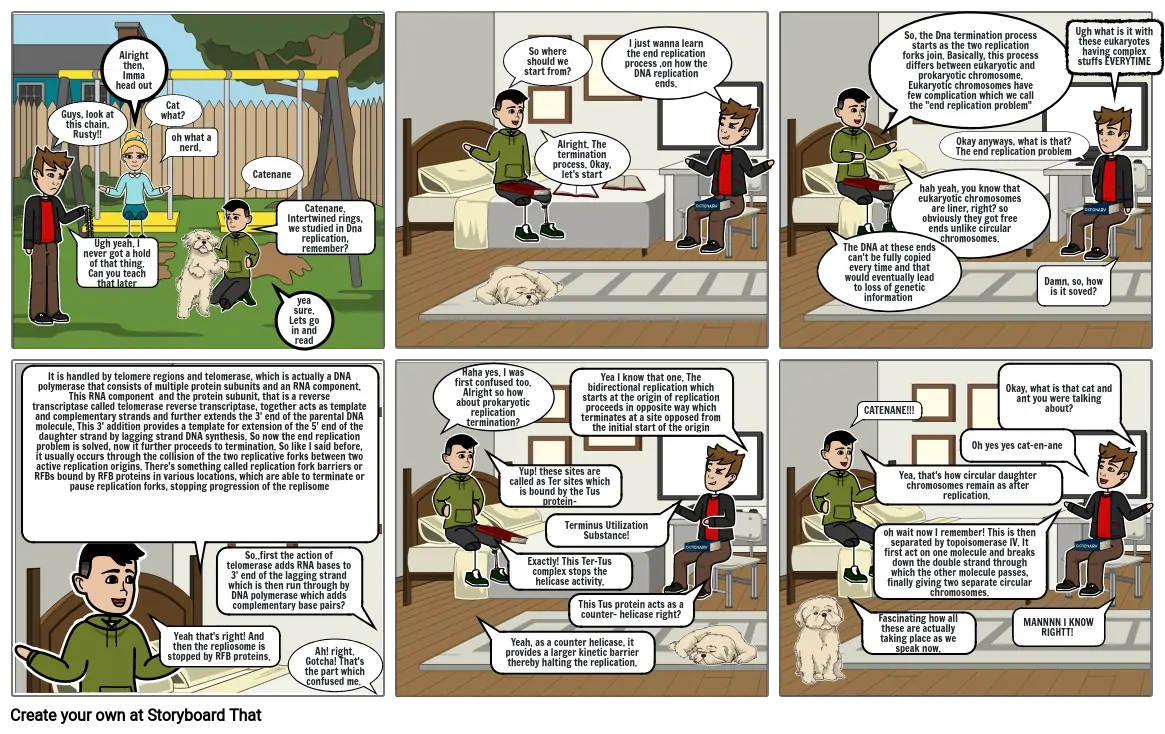DNA replication termination

Storyboard Text
- Guys, look at this chain. Rusty!!
- Ugh yeah. I never got a hold of that thing. Can you teach that later
- Alright then, Imma head out
- Cat what?
- oh what a nerd.
- Catenane
- Catenane. Intertwined rings, we studied in Dna replication, remember?
- yea sure. Lets go in and read
- So where should we start from?
- Alright. The termination process. Okay, let's start
- I just wanna learn the end replication process ,on how the DNA replication ends.
- So, the Dna termination process starts as the two replication forks join. Basically, this process differs between eukaryotic and prokaryotic chromosome. Eukaryotic chromosomes have few complication which we call the "end replication problem"
- hah yeah, you know that eukaryotic chromosomes are liner, right? so obviously they got free ends unlike circular chromosomes.
- Okay anyways, what is that? The end replication problem
- The DNA at these ends can't be fully copied every time and that would eventually lead to loss of genetic information
- Damn, so, how is it soved?
- Ugh what is it with these eukaryotes having complex stuffs EVERYTIME
- It is handled by telomere regions and telomerase, which is actually a DNA polymerase that consists of multiple protein subunits and an RNA component. This RNA component and the protein subunit, that is a reverse transcriptase called telomerase reverse transcriptase, together acts as template and complementary strands and further extends the 3' end of the parental DNA molecule. This 3' addition provides a template for extension of the 5' end of the daughter strand by lagging strand DNA synthesis. So now the end replication problem is solved, now it further proceeds to termination. So like I said before, it usually occurs through the collision of the two replicative forks between two active replication origins. There's something called replication fork barriers or RFBs bound by RFB proteins in various locations, which are able to terminate or pause replication forks, stopping progression of the replisome
- Yeah that's right! And then the repliosome is stopped by RFB proteins.
- So..first the action of telomerase adds RNA bases to 3' end of the lagging strand which is then run through by DNA polymerase which adds complementary base pairs?
- Ah! right. Gotcha! That's the part which confused me.
- Haha yes. I was first confused too. Alright so how about prokaryotic replication termination?
- Yeah, as a counter helicase, it provides a larger kinetic barrier thereby halting the replication.
- Yup! these sites are called as Ter sites which is bound by the Tus protein-
- Exactly! This Ter-Tus complex stops the helicase activity.
- Terminus Utilization Substance!
- This Tus protein acts as a counter- helicase right?
- Yea I know that one. The bidirectional replication which starts at the origin of replication proceeds in opposite way which terminates at a site opposed from the initial start of the origin
- Fascinating how all these are actually taking place as we speak now.
- CATENANE!!!
- Yea, that's how circular daughter chromosomes remain as after replication.
- oh wait now I remember! This is then separated by topoisomerase IV. It first act on one molecule and breaks down the double strand through which the other molecule passes, finally giving two separate circular chromosomes.
- Oh yes yes cat-en-ane
- Okay, what is that cat and ant you were talking about?
- MANNNN I KNOW RIGHTT!
Over 30 Million Storyboards Created

